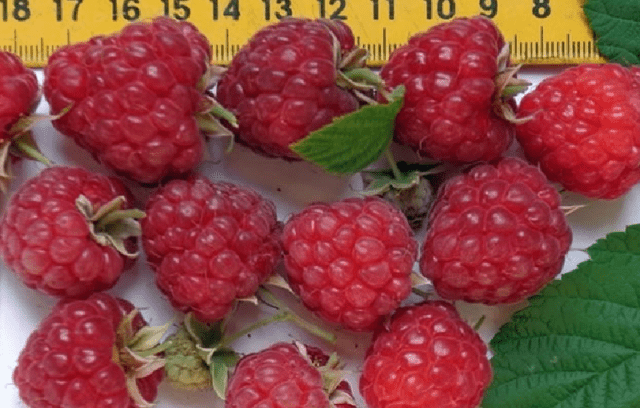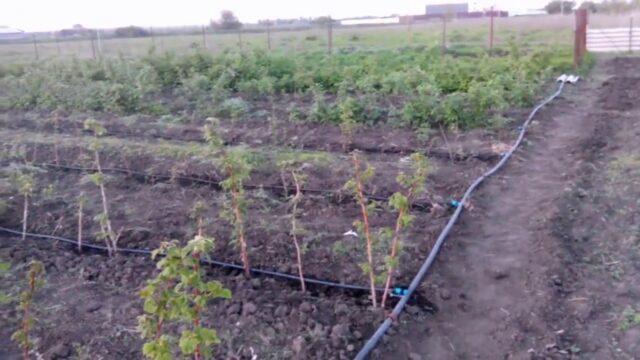Content
Raspberry Cleopatra is a large-fruited variety that is resistant to diseases and pests. Gardeners appreciated the new product of Russian selection for its productivity and resistance to adverse conditions.
History of appearance
The originator (patent holder) of the mid-early raspberry Cleopatra is the Federal State Budgetary Institution "Federal Scientific Center named after. V. Michurina." The culture was included in the Register of Breeding Achievements of Russia in 2017.
To create Cleopatra, three varieties were used: Obilnaya, Maroseyka, Barnaulskaya.
Raspberries are recommended for cultivation in the Central Black Earth region. The Cleopatra variety is successfully cultivated in Belgorod, Kursk, Voronezh, Oryol, Tambov, Lipetsk and other regions.
Description of raspberry variety Cleopatra
Raspberry Cleopatra is a remontant crop. It is characterized by high winter hardiness and unpretentiousness to growing conditions.
Fruit
Cleopatra raspberries have the shape of a large truncated cone.The weight ranges from 3-5 g. The fruits have slight pubescence. The color of the berries is rich, dark red.

The taste of Cleopatra raspberries is sweet, with a subtle sourness.
The harvest is suitable for use both fresh and for all kinds of preparations. Compotes, preserves, and jam are made from raspberries. It is added to desserts and frozen.
Bush
Mid-season raspberry bushes Cleopatra are upright. They reach a height of 1.5-2 m. The culture is compact, spreading is average.
Young raspberry shoots are light brown, have a slight waxy coating, and no pubescence. A small number of thorns are formed in the lower part of the stem. The shoots become dark brown at the age of two. They are covered with spines along their entire length.

The foliage of the Cleopatra raspberry is dark green, the edges of the plates are serrated
Color may vary depending on growing conditions. Along the edges of the leaf blades the color is lighter, and in the middle it is rich, with an anthocyanin tint.
Characteristics of raspberry Cleopatra
Before purchasing a variety for cultivation, you need to familiarize yourself with its characteristics. Raspberries Cleopatra are remontant, i.e. the crop is harvested almost throughout the season.
Ripening time and yield
Maturation is extended over time. In the Cleopatra variety it is uneven. The first wave of collection occurs in the third decade of June - early July. The second peak of raspberry fruiting begins on the 20th of August and lasts until the first autumn frosts.
The average yield is 3.5-4 kg per bush. From one square meter you can collect about 6 kg (when placing plants at a distance of 70 cm from each other).
Taste
According to the tasting assessment, the variety received 4.6 points out of 5. The raspberry pulp is tender, with a high content of juice.The aroma is pleasant, characteristic of the culture.
Frost resistance
Raspberry Cleopatra has average frost resistance. According to the description of the originator, the culture can withstand frosts down to minus 15 °C. In regions with colder winters, bushes must be covered.
Disease resistance
The Cleopatra variety inherited increased disease resistance from its mother crops. With proper care, raspberries are not afraid of anthracnose, spotting, and rust.
Pros and cons of the variety
The Cleopatra variety, which recently appeared on the crop market, has managed to win the love of gardeners. It is valued for its large fruit, good yield, and unpretentiousness.

With a lack of moisture and sunlight, sourness may be present in the Cleopatra raspberry fruits
Pros:
- dessert taste;
- average yield;
- slight formation of shoots, which makes caring for the crop easier;
- resistance to major diseases;
- winter hardiness;
- mid-early harvest date;
- long period of berry appearance.
Minuses:
- in extreme heat, fruits can bake in the sun;
- there is no resistance to drought, the bushes need additional watering.
Features of growing raspberries Cleopatra
The Cleopatra variety develops fully in good lighting. For planting, choose open areas protected from drafts.
The occurrence of groundwater should not be close to the surface, otherwise the bushes will suffer from rot.
Planting scheme
Cleopatra raspberries are planted in spring or autumn. Choose southern areas, protected from the wind by a fence or building wall. The bushes are compact, so they can be planted at a distance of 0.7-1 m from each other.Leave 1.5-1.7 m between rows.
The culture prefers soil with a slightly acidic reaction. If the soil is highly acidic, dolomite flour or lime is added to the site before planting.
Rules of care
To achieve maximum yield, you need to follow simple recommendations:
- The Cleopatra variety is responsive to fertilizing. Nutrients are applied several times per season. During the period of bud swelling, ammonium nitrate, phosphate compounds and ash are used. During flowering, it is recommended to apply natural products: diluted bird droppings (1:20), mullein (1:10). Complex fertilizers (without nitrogen) are used at the end of summer. This guarantees a good harvest for the next season.
- The crop needs timely pruning. In the spring, when the first leaves appear, the shoots are shortened by 1/3 of their length. In the autumn, fruit-bearing (two-year-old) branches are removed.
- The bushes are tied to a support installed during planting. If the structure was not laid in the first year, then next spring it is necessary to take care of its arrangement. The garter makes caring for the plant and harvesting easier.
- Watering should be regular. The Cleopatra variety is not resistant to drought, so in the absence of rain it is necessary to take care of additional moisture of the area. Young seedlings are watered every other day, adult bushes - 1-2 times a week.
- When growing remontant raspberries in regions with cold winters, it is necessary to provide shelter for the bushes. To do this, they are removed from the support, bent 40-50 cm from the ground, covered with spruce branches, and covered with snow in winter.In the absence of snow cover, agrofibre is used, which is stretched over the supports. Bending down the shoots is carried out before the onset of frost, while the branches are still flexible. When it gets colder, the shoots become fragile and are damaged when trying to bend them.
- Mulching helps prevent the growth of weeds, which has a positive effect on the condition of raspberries. Wood shavings, pine litter, and straw are used as mulch. For the winter, the soil is insulated with a new layer of mulching materials. This will prevent the roots from freezing.
Prevention of diseases and pests
Raspberry Cleopatra is highly resistant to diseases, but this is only possible under comfortable growing conditions.
Preventive actions:
- Removing all fallen leaves and weeds. This event is necessary to prevent fungal spores and insect larvae from successfully overwintering under the bushes.
- Spraying with folk remedies helps prevent the appearance of aphids, weevils and other pests. To do this, use infusions of garlic, onion, tobacco with the addition of soap shavings.
- Timely identification and pruning of diseased shoots. Upon visual inspection, you may notice spotting, wilting, or curling of the foliage. Affected shoots are sprayed with fungicides (Abiga-Pik, Oksikh, Ordan), copper sulfate, Bordeaux mixture, or cut off.
Timely watering and fertilizing will help to grow raspberries with good immunity to disease.
Conclusion
Raspberry Cleopatra is a remontant variety characterized by a high yield. The culture is unpretentious and characterized by sufficient frost resistance. In regions with cold winters, it requires shelter.The extended fruiting period allows you to use vitamin-rich berries all summer and make preparations for the winter.










